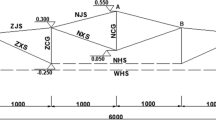Abstract
Large span cable-supported structures have been developed rapidly in China, and they always adopt high-strength steel cables as structural members. However, the modulus of elasticity and yield strength of steel material will decrease seriously under fire conditions while fire protection is unlikely to be provided for steel cable. Several typical large span cable-supported structures such as cable truss, beam string structure and prestressed cable net are studied on their structural behaviour in this paper. Theoretical formulae are derived in terms of geometrical and material nonlinearity with high temperature effect. Finite element models are also established to simulate the structural performance under fire conditions. The calculation formulae for fire-resisting design are suggested for these three types of structures, while displacement and prestressed force variation rules are also given.
Similar content being viewed by others
References
Max Irvine H. Cable Structures. Cambridge: The MIT Press, 1981
Wakefield D S. Engineering analysis of tension structures: theory and practice. Eng Struct, 1999, 21: 680–690
Li G Q. Refractory design of steel construction. China International Steel Construction Congress, 2004. 266–276
Shi Y J, Bai Y, Wang Y Q. Study on performance-based fire-resisting design and key technique thereof for large space steel structures. Eng Mech (in Chinese), 2006 (suppl I): 119–126
Bai Y, Shi Y J, Wang Y Q. Analysis on fire-resisting performance-based design method and engineering instances for large-space structures in China. Proceedings of the Ninth International Symposium on Structural Engineering for Young Experts, 2006, 1: 783–788
Pietrzykowski J. Elastic-plastic behaviour of pre-stressed materials. Engineer, 1964, 217: 385–388
CEN. Eurocode3-Design of Steel Structures, Part1.2: Structural Fire Design. Brussels: CEN, 2002
CEN, Eurocode4-Design of Composite Steel and Concrete Structures, Part 1–2: General Rules-Structural Fire Design. Brussels: CEN, 2003
Qian R J, Yang L P. Analysis, Design and Construction of Pretensioning Structure (in Chinese). Nanjing: SoutheastUniversity Press, 2003. 29–30
Saitoh M. Role of string-aesthetics and technology of the beam string structures. Proceedings of the LSA 98 Conference “Light Structure in Architecture Engineering and Construction”, 1998. 692–701
Tabarrok B, Qin Z. Nonlinear analysis of tension structures. Comput Struct, 1992, 45(5–6): 973–984
Shen S Z, Xu C B, Zhao C. Design of Cable Structures (in Chinese). Beijing: China Construction Industry Press, 2006. 28–40
Ariel H. Aspects of design of double-layer tensegrity domes. Int J Space Struct, 1992, 7(2): 38–49
Author information
Authors and Affiliations
Corresponding author
Rights and permissions
About this article
Cite this article
Bai, Y., Shi, Y. & Wang, Y. Theoretical analysis and numerical simulation on behaviour properties of large span cable-supported structures under fire conditions. Sci. China Ser. E-Technol. Sci. 52, 2340–2349 (2009). https://doi.org/10.1007/s11431-008-0194-6
Received:
Accepted:
Published:
Issue Date:
DOI: https://doi.org/10.1007/s11431-008-0194-6




